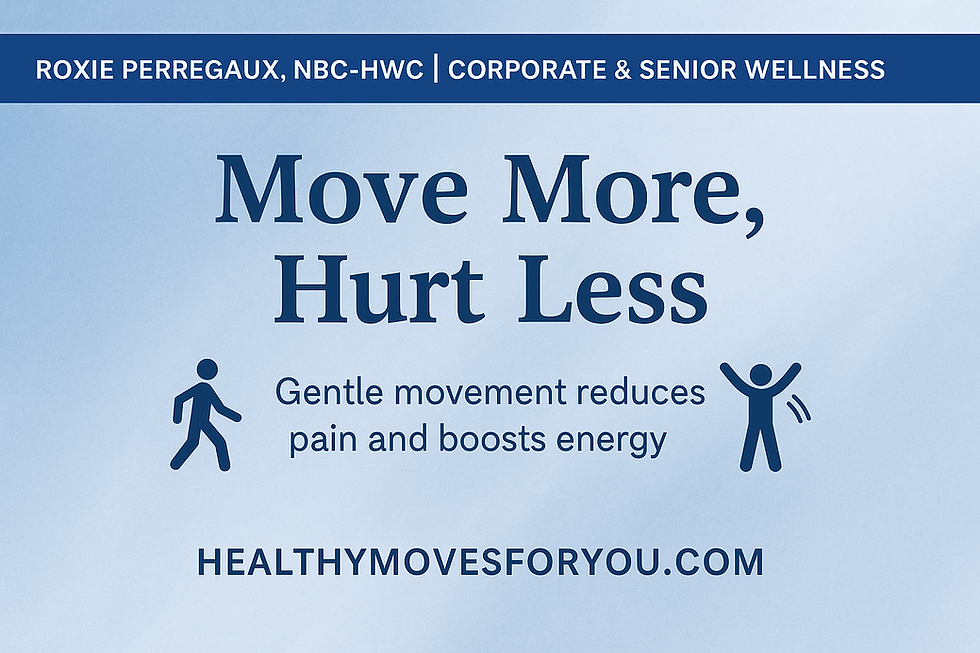Why Balance is Key to Aging Well (And How to Improve Yours)
- Roxie Perregaux

- Mar 17
- 3 min read

As we age, our bodies undergo changes that can affect our strength, mobility, and coordination. One of the most important aspects of staying healthy and independent as we age is maintaining good balance. Poor balance can increase the risk of falls, which can lead to serious injuries, but the good news is that balance can be improved with a little attention and effort.
In today’s post, I’m diving into why balance is so crucial for seniors and offering practical tips you can incorporate into your daily routine to keep your balance sharp.
Why Balance Matters for Seniors
Good balance is essential for everyday activities, like walking, climbing stairs, and even standing up from a chair. When our balance begins to decline, it can affect our confidence and independence. Poor balance is also linked to an increased risk of falls, which is a major concern for seniors. Falls can lead to broken bones, hospital visits, and long recovery times.
The good news is that you don’t have to be a gymnast to improve your balance. Simple exercises and lifestyle changes can go a long way in enhancing your stability.
How to Improve Your Balance:
Practice Balance Exercises One of the best ways to improve your balance is by doing balance exercises. These exercises are designed to strengthen the muscles that support your joints and improve your coordination. Some simple balance exercises include:
Standing on one leg: Hold onto a sturdy chair or countertop for support. Stand on one leg for 10-15 seconds, then switch legs. Over time, you can increase the duration.
Heel-to-toe walking: Imagine you’re walking on a tightrope, placing one foot directly in front of the other as you walk in a straight line.
Pro Tip: Incorporate these balance exercises into your daily routine—try them for just 5 minutes in the morning or before bed!
Strengthen Core Muscles Strong core muscles are crucial for good balance. A strong core helps stabilize your entire body, making it easier to stay balanced during daily activities. Some great exercises to strengthen your core include:
Seated marches: Sit in a chair with your feet flat on the floor, and then march in place, lifting one knee at a time.
Planks: A simple plank (holding your body in a push-up position) engages your core and improves stability.
Pro Tip: Even simple core exercises can help improve posture and prevent falls.
Focus on Flexibility and Stretching Tight muscles can make it harder to maintain your balance. Stretching regularly improves flexibility, which allows your body to move more freely and helps prevent falls. Incorporating a daily stretching routine can make a significant difference in your stability.
Pro Tip: Stretch your hips, calves, and hamstrings to improve flexibility and range of motion.
Take Your Time When it comes to balance, rushing is never a good idea. Take your time when standing up from a chair, getting in and out of the car, or walking across the room. Avoid quick, sudden movements, as they can make you feel unsteady.
Pro Tip: Slow down and focus on your movements to maintain your balance throughout the day.
Wear Proper Footwear The shoes you wear play a big role in your balance. Shoes that are too loose, too tight, or have slippery soles can increase the risk of falls. Choose shoes that offer good support, a low heel, and a non-slip sole.
Pro Tip: Check your shoes regularly to ensure they’re in good condition and provide the right support.
Conclusion: Balance = Confidence
By focusing on exercises that strengthen your core and improve your balance, you’ll not only reduce the risk of falls, but you’ll also feel more confident and independent in your daily life. Remember, it doesn’t take much to get started—just a few minutes a day can make a huge difference over time.
What are some of your favorite balance exercises? Share them in the comments below, and feel free to reach out if you’d like more tips on staying safe and strong as you age.




Comments